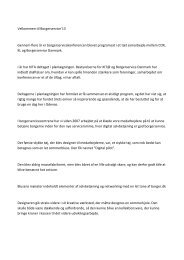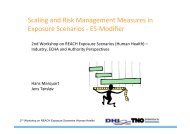Clusters are individuals - VDI/VDE-IT
Clusters are individuals - VDI/VDE-IT
Clusters are individuals - VDI/VDE-IT
Create successful ePaper yourself
Turn your PDF publications into a flip-book with our unique Google optimized e-Paper software.
The majority of cluster management organizations (77 out<br />
of 143 cluster management organizations) depend to more<br />
than 60 per cent on public funding. The budget of 43 cluster<br />
management organizations (roughly one third of the comparative<br />
portfolio) depends to more than 80 per cent on public<br />
funding. Only 29 cluster management organizations depend<br />
to less than 19 per cent on public funding (see Table 4).<br />
SHARE OF PUBLIC FUNDING IN TOTAL FUNDING 0 – 19 % 20 – 39 % 40 – 59 % 60 – 79 % > 80%<br />
NUMBER OF CLUSTERS 29 11 26 34 43<br />
Table 4: Sh<strong>are</strong> of public funding in total funding of cluster management organizations.<br />
2.3 KEY FINDINGS<br />
The analysis of the data that was gathered through the<br />
benchmarking of 143 cluster management organizations<br />
has yielded five key findings which <strong>are</strong> further detailed in<br />
this chapter. The key findings (see Table 5) give further insight<br />
into the characteristics of clusters, particularly with regard<br />
to the difference between research- and industry-driven<br />
clusters, the impact of cluster management organizations<br />
on the cluster in terms of business and R&D activities, the<br />
effect of the technology <strong>are</strong>a on cluster characteristics and<br />
the impact of services provided by the cluster management<br />
organization on the development of the cluster. With regard<br />
to the key findings there is no country-specific analysis as<br />
there <strong>are</strong> no significant differences that can be explained by<br />
country-specific variables.<br />
KEY FINDINGS<br />
1. Research-driven clusters <strong>are</strong> much more similar to industry-driven clusters than expected<br />
2. <strong>Clusters</strong> with a low or high sh<strong>are</strong> of public funding <strong>are</strong> similar in terms of structure and governance, but different in terms of impact<br />
3.<br />
The visibility and attractiveness of a cluster and the impact of the cluster management organization on SME development depends<br />
on its size, age, institutionalization and degree of industrial orientation<br />
4. The characteristics of a cluster depend on the technology field it is operating in<br />
5. <strong>Clusters</strong> with a high impact on business activities of SME feature an active cluster management<br />
Table 5: Overview of key findings<br />
2.3.1 RESEARCH-DRIVEN CLUSTERS ARE MUCH MORE SIMI-<br />
LAR TO INDUSTRY-DRIVEN CLUSTERS THAN EXPECTED<br />
Research-driven clusters whose objectives and activities <strong>are</strong><br />
set by research-actors such as research institutions or universities<br />
<strong>are</strong> much more similar to industry-driven clusters<br />
whose agenda is set by companies than previous research<br />
suggested.<br />
Between these two types of clusters there <strong>are</strong> no or only minor<br />
differences in terms structural factors such as financing,<br />
governance, legal form, regional concentration and degree<br />
of specialization. R&D-driven clusters <strong>are</strong> a little bit smaller<br />
in terms of numbers of members than industry-driven clusters.<br />
They <strong>are</strong> also significantly younger than industry-driven<br />
clusters (see Figure 8).<br />
23

















